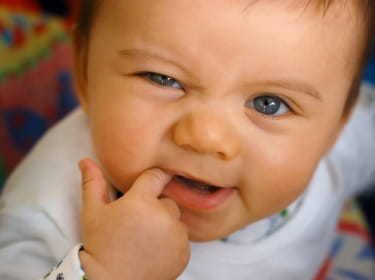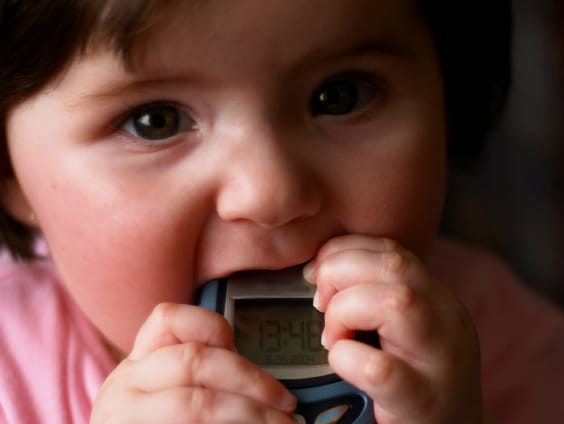Teething Gels: A Warning

The Bottom Line
Benzocaine is a local anesthetic (medicine that numbs skin and gums). Teething gels are among the over-the-counter preparations that contain benzocaine. However, even small amounts of benzocaine are dangerous for infants; it can prevent the bloodstream from carrying oxygen throughout the body.

The Full Story
Teething gels and lotions with benzocaine should not be used on children under the age of two. Benzocaine is a medicine applied directly to children's gums to ease pain. Unfortunately, benzocaine also can affect red blood cells, lowering the amount of oxygen in the bloodstream. This rare condition, called methemoglobinemia, can be fatal.
The Food and Drug Administration (FDA) warns parents not to use benzocaine for children under two years old, even if there is no warning on the label. Using even the labeled amounts on infants can cause serious illness. Children with methemoglobinemia may develop blue or gray skin and lips, have seizures, have trouble breathing, or stop breathing altogether. Symptoms can occur within a few minutes or up to two hours later. This type of reaction can happen the first time the drug is used or after it's been used many times.
The American Academy of Pediatrics notes that these gels and lotions may not even be useful. They mix with saliva and are swallowed within a short time. Instead, the pediatricians recommend hard rubber teething rings (but not frozen) and massaging children's gums for comfort. If teething infants remain extremely uncomfortable, contacting the pediatrician is the best next step.
Benzocaine is also found in pain-relieving creams and lotions for adults. Following label instructions exactly is extremely important. Adults can also develop methemoglobinemia, and even die, if too much benzocaine is applied, if it is applied too often, or if the treated area is covered up too tightly.
Prevent poisonings from benzocaine teething preparations:
- Do not use teething preparations containing benzocaine on children younger than two years old.
- Be sure to follow label instructions for children age two and older and for adults.
- ALWAYS store medicines with benzocaine (and all medicines) locked up, out of sight and reach of children.
If you mistakenly use benzocaine on an infant, or if someone may have swallowed a medicine containing benzocaine, use the webPOISONCONTROL® online tool for guidance or call the poison specialists immediately at 1-800-222-1222. webPOISONCONTROL and the poison specialists will help you figure out if you should go to the emergency room or if the situation can be managed safely at home.
Rose Ann Gould Soloway, RN, BSN, MSEd, DABAT emerita
Clinical Toxicologist
Poisoned?
Call 1-800-222-1222 or
Prevention Tips
- Do not use teething preparations containing benzocaine on children younger than two years old.
- Be sure to follow label instructions for children age two and older and for adults.
- ALWAYS store medicines with benzocaine (and all medicines) locked up, out of sight and reach of children.
This Really Happened
A mother treated her child's tooth pain with an over-the-counter remedy containing benzocaine. The next morning, the child swallowed a small amount of this medicine. Within 2 hours, his lips and nail beds had turned blue and his skin was "dusky". In the emergency room, his blood was found to be dark brown. Nearly half of his hemoglobin, which carries oxygen in the blood, had turned to methemoglobin, which cannot carry oxygen. The child was treated with an antidote and admitted to the hospital. He had recovered by the following morning.
Reference: Darracq MA, Daubert GP. A cyanotic toddler. Pediatric Emergency Care. 2007; 23: 195-199.An 18-month-old girl played with a tube of Baby Orajel® (benzocaine 7.5%). She had the product all over her hands and her mom smelled it on her breath. Poison Control advised her mom to wash her skin, rinse her mouth and watch her closely over the next hour for drowsiness and/or pale or dusky skin color. The child was fine according to her mom during a follow-up call from Poison Control about an hour later.
For More Information
American Academy of Pediatrics. Ages & Stages. Teething: 4 to 7 Months. Accessed March 12, 2014.References
U.S. Food and Drug Administration. FDA Drug Safety Communication: Reports of a rare, but serious and potentially fatal adverse effect with the use of over-the-counter (OTC) benzocaine gels and liquids applied to the gums or mouth. Accessed Mar 12, 2014.Poisoned?
Call 1-800-222-1222 or
Prevention Tips
- Do not use teething preparations containing benzocaine on children younger than two years old.
- Be sure to follow label instructions for children age two and older and for adults.
- ALWAYS store medicines with benzocaine (and all medicines) locked up, out of sight and reach of children.
This Really Happened
A mother treated her child's tooth pain with an over-the-counter remedy containing benzocaine. The next morning, the child swallowed a small amount of this medicine. Within 2 hours, his lips and nail beds had turned blue and his skin was "dusky". In the emergency room, his blood was found to be dark brown. Nearly half of his hemoglobin, which carries oxygen in the blood, had turned to methemoglobin, which cannot carry oxygen. The child was treated with an antidote and admitted to the hospital. He had recovered by the following morning.
Reference: Darracq MA, Daubert GP. A cyanotic toddler. Pediatric Emergency Care. 2007; 23: 195-199.An 18-month-old girl played with a tube of Baby Orajel® (benzocaine 7.5%). She had the product all over her hands and her mom smelled it on her breath. Poison Control advised her mom to wash her skin, rinse her mouth and watch her closely over the next hour for drowsiness and/or pale or dusky skin color. The child was fine according to her mom during a follow-up call from Poison Control about an hour later.
